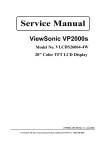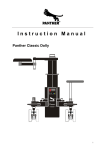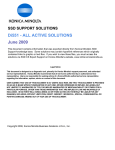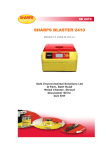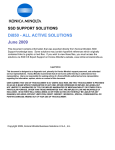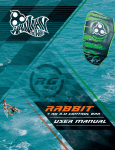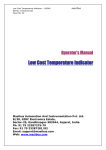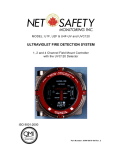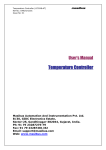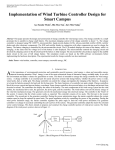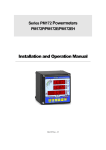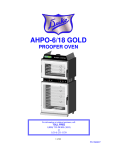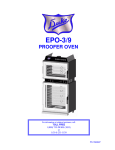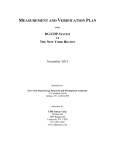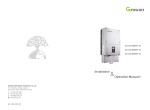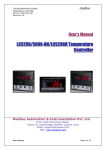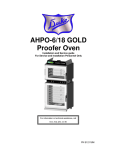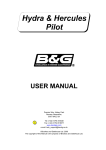Download 0404M006 Rev1-0 2 year e400i 250Vdc Mar 2009
Transcript
Kestrel e400i250Vdc Type 0404-3000-250 for Gridtie Applications With Conditional Two Year Warranty Installation and Maintenance Manual To report errors, omissions or improvements please write to: [email protected] or [email protected] Owners Notes (Record the serial numbers before installation!) Turbine Serial Number __________________ Blade 1 S/N Blade 2 S/N Blade 3 S/N ______________ _____________ _____________ General Notes: Document No. 0404M006 Revision 1,0 Date: March 2009 2 Index 1.0 Safety Warnings and Notes 4 1.1 Safety Symbols 5 2.0 The Tower 6 2.1 Mounting Flange and Tower Top 7 3.0 Unpacking the Wind Turbine 8 4.0 Turbine assembly and Installation 10 4.1 Identification Marking 4.2 Tail Assembly 4.3 Tail Boom Weld assembly to the Generator 4.4 Generator to the Tower 4.5 Tail Assembly to the Boom 4.6 Blades and Nosecone Stiffener Ring 4.7 Balancing the Blades 4.8 Nacelle and Nosecone 5.0 Electrical Installation 19 6.0 Installation Commissioning 22 7.0 Maintenance Schedule 23 7.1 Wind Power Class 7.2 Planned Maintenance schedule 8.0 Questions and Answers 25 9.0 Technical Specification 26 10.0 Compliance 27 11.0 Warranty 28 12.0 Annexures Annexure 1 Annexure 2 Annexure 3 Annexure 4 Annexure 5 Annexure 6 General Information Choosing a Site Kestrel Patented Voltage Limiter Gridtie Inverters Installation Check List Warranty Registration Document No. 0404M006 Revision 1,0 29 32 34 35 36 37 Date: March 2009 3 Disclaimer Kestrel Wind Turbines makes every effort to give accurate information in this manual and is in no way liable for any error or omission. The user of this manual assumes full responsibility and risk We appeal to your common sense to read and apply the safety notes. Consult a professional engineer and take advice if you are unsure. 1 Safety and Warning Notes Accidents can easily occur and there are always inherent dangers associated with any type of machine. Tower installations pose their own dangers. Always work carefully and have an assistant wherever possible. All installation work should be completed at ground level wherever possible. Be very aware of the blades during installation. Consult a civil engineer or reputable builder if you are unsure. Maintain a healthy respect for this wind turbine. Use good handling methods and take precautions to avoid physical injury. The Kestrel e400i output voltage can become dangerous and even lethal when running on open circuit. Always short the output wires together when the turbine is disconnected. Do not work on the system when the turbine is running or when lightning is possible. Disconnecting any wire may result in a spark. The presence of explosive hydrogen from battery charging is always a possibility. Adequate ventilation must be provided for battery installations. Wire sizes must be correct for the powers supplied. Fire can result from shorts created on a battery. Respect the system and use common sense. Consult a qualified electrician if you are unsure. Slack bolts, poor workmanship and loose electrical connections must be avoided. The turbine blades are dangerous. Respect a rotating turbine. Always shut the turbine down before approaching by operating the brake switch on the controller or shorting the generator output. Preventative maintenance is always the best. Checks are best carried out in calm weather conditions. Avoid any maintenance or inspection during windy weather. Document No. 0404M006 Revision 1,0 Date: March 2009 4 1.1 Safety Symbols The symbols shown are used throughout this manual to highlight safety points General caution warning Danger of hand injury Danger of electrical shock Injury from blades Work Instructions Asterisk denotes a special instruction or reminder. ► Arrow head denotes an assembly/build instruction. Document No. 0404M006 Revision 1,0 Date: March 2009 5 2.0 The Tower Three possible tower types are shown above. The most affordable erection is a guyed tower that is raised and lowered with a jin pole The guyed tower can be constructed to great heights using a lattice frame as the pole section. It requires the largest footprint and more maintenance checks. The tripod tower is also raised and lowered with a jin pole. Being free standing, it is of a much heavier and rigid construction. Cost restricts the practical height but a small footprint often makes it a popular choice. A scissor tower is the usually the most expensive erection and is cost restricted in height. It gives the safest and most convenient installation. The turbine can be simply raised and lowered for inspection and maintenance with all work being done at ground level. Once again the footprint is small and the ground area required to lower the tower is less than other towers. Other tower types include lattice construction and monopole taper towers. Kestrel supplies standard approved towers and can provide the turbine characteristics and parameters for tower design. The e400i has a tower top mass of approximately 220kg (485lbs) and is not considered suitable for roof mounting or fitting to outrigger systems on existing masts or towers. Document No. 0404M006 Revision 1,0 Date: March 2009 6 2.1 Mounting Flange and Tower Top The Kestrel e400i is mounted on the tower with a circular flange. A suitable matching tower flange is supplied with the turbine. The following specification is recommended for the top pipe section of the tower. Mild steel pipe grade 350WA OD139,7mm (5,5”). Length of 2m (77”) and minimum wall thickness of 4,5mm (0,177”). A standard adapter pipe is available from Kestrel where the turbine will be fitted to an alternative structure. The pole includes a securing point for the tower cable. Consult your dealer for more details. Document No. 0404M006 Revision 1,0 Date: March 2009 7 3.0 Unpacking the Wind Turbine A Packing list is packed with the product. Ensure that all parts are present. Notify your dealer of any shortages. The e400i is contained in one shipping crate. Check the crate for any transit damage and then carefully remove the top of the crate to reveal the contents. Check that everything is intact. Pay special attention to the blade package. Carefully remove all the parts for safe storage. The last item to be removed is the generator assembly, which is fully secured to the packing case base. The generator and pitch control is factory assembled. The complete assembly weighs approximately 150kg. Document No. 0404M006 Revision 1,0 Date: March 2009 8 Unpack and check the following parts. Inform your supplier of any defects or shortages. ► Remove the blade package and store safely. ► Remove the nacelle and nosecone with ring and store safely. ► Remove the two boom sections. ► Remove the two tail plates. ► Remove any other accessories that were shipped for you. ► Locate and remove the fastener pack (assembly grease inc.). ► Remove the complete generator assembly. Note: The fasteners are supplied in marked bags. Each bag contains a set of fasteners for different parts of the turbine. The enclosed grease is used on all nuts from M10 upwards. Note: One additional fastener pack contains one spare unit of every fastener used on the turbine. Lifting Eye Here It may be useful to remove the sides of the packing case to access the assembly. Remove the securing bolts and pads to free the generator assembly. If possible, use lifting gear to remove the assembly from the case. Otherwise have at least three other assistants to lift the assembly from the case. Two lifting straps may be fitted to the generator for lifting. Beware of the generator tipping forward and causing injury to hands. Beware not to damage the output cables below the generator. The generator assembly is heavy at the front and will easily tip over. When installed, the turbine is balanced on the yaw shaft. Document No. 0404M006 Revision 1,0 Date: March 2009 9 4.0 Turbine Assembly and Installation You will need the following hand tools. ► Trestle, table or other support to support the turbine that is safe for 250kg (550lbs). ► Plastic or rubber mallet. ► Full set of ring spanners from 10mm – 22mm. ► Metric socket wrench set. ► set of standard screwdrivers (plain and Philips). ► Torque wrench suitable for torques of 0 – 180Nm (132lb ft). ► electrical pliers and cutters. Refer to the diagrams and follow the instructions to assemble the complete wind turbine. This manual assumes that the support tower is already installed and lowered to ground level ready for turbine installation. 4.1 Identification Marking The turbine is fitted with a rating label similar to the image. Note down your turbine serial number for future reference! Document No. 0404M006 Revision 1,0 Date: March 2009 10 4.2 Tail Assembly Observe hole position on top of boom ASSEMBLE EXACTLY AS SHOWN IN THE DIAGRAM. FIT ALL THE FASTENERS BEFORE TIGHTENING. The tails will be in the middle line of the boom You need the fastener bag marked “Tail Assembly” for this work. ► Top (2) and bottom (3) tail plate to boom (1) with four off stainless bolt sets (6). Nuts and washers on the bottom. ► Two rear stiffeners (4) to boom (1) with one stainless bolt set (6). ► Two front stiffeners (4) to boom (1) with one stainless bolt set (6). ► Bolt all stiffeners (4) and (5) to top and bottom tail plates (2) and (3) with four off bolt set (7). ► All tail fasteners are M6. Torque all fitted bolts to 10Nm (7.5ft lb). Document No. 0404M006 Revision 1,0 Date: March 2009 11 4.3 Tail Boom Weld Assembly to the Generator THE GENERATOR SHOULD BE FITTED ON THE TOWER BEFORE FITTING THE TAIL ASSEMBLY TO THE GENERATOR. FIT ALL THE FASTENERS BEFORE TIGHTENING. ASSEMBLE EXACTLY AS SHOWN IN THE DIAGRAM. You need the fastener bag marked “Tail Boom weld Assembly” for this work. ► Fit the boom (8) to the tail boom flange (9) with two bolt sets (10) (put a little grease on the nut thread). Torque to 50Nm (36ft lb). ► Fit the assembled flange and boom to the generator with all eight allen cap screws and spring washers (11). Torque to 50Nm (36ft lb). ► Store the remaining fasteners for later use. Document No. 0404M006 Revision 1,0 Date: March 2009 12 4.4 Generator to the Tower The already installed tower is lowered to ground level before mounting the generator. The power cable is also fitted. The eight fixing bolts must be HT 8,8 (High Tensile grade 8,8). Secure the tower cable at the top of the tower. The tower cable must not hang or pull on the generator cables. Leave enough tower cable to make the connection to the generator. Do not “spin” the generator by hand. Short the red (+ve) and black (-ve) generator output cables until wiring is to be done. Avoid damage to any paint finishes by protecting with suitable sundry material (HD foam, carpet tiles, cloth rags etc). Make all power cables ends safe by insulation before installing the generator. Document No. 0404M006 Revision 1,0 Date: March 2009 13 You need the fastener bag marked “Generator Mounting”. ► Support the lowered tower at a suitable height to receive the generator. Be sure that the support can bear the weight after the generator is mounted Allow for 250kg (550lbs). ► Support the generator at a similar height with the mounting flange in line with the tower flange. Observe polarity on electrical connections. Connect +ve (red) and –ve (black) generator output cables correctly. Reverse polarity will damage the generator and any connected equipment. ► Remove the short across the generator wires. Make and complete the electrical connection between the generator and the tower cable. The 250Vdc generator produces up to 13Amps under normal operation but can supply 18A when shorted. Use connectors rated for 30A. It is very important to ensure that this connection is good and secure and completely watertight. ► Fit the generator to the tower while storing the cable and connector down the inside of the tower. Fit the eight M16 HT bolts and nuts (nuts on the bottom) and tighten. Ensure that the cable is not damaged during this operation. Torque the flange bolts to 120Nm (88ft lbs). Document No. 0404M006 Revision 1,0 Date: March 2009 14 4.5 Tail Assembly to the Boom You need the fastener bag marked “Tail Boom weld Assembly” for this work. Slide the nacelle over the boom weld assembly before fitting the tail assembly !! ► Slide the tail assembly to the boom as shown. Place a little grease inside the nut thread. Fit the two stainless M10 bolt sets (16). Torque to 35Nm (25ft lb). ► Raise the tower and generator to a suitable height from the ground for blade fitment. Document No. 0404M006 Revision 1,0 Date: March 2009 15 4.6 Blades and Nosecone Stiffener Ring You need the fastener bag marked “Blade Fasteners” for this work. Fit the Nosecone stiffener ring over the pitch control before fitting the blades and leave it loose in place !! ► Offer the first blade to the blade mount. The blade serial number must face forward and be visible from the front. Stainless nuts can sieze on the bolt. Put a little waterproof grease inside the stainless nut before fitting. ► Inset the two bolts through the compression plate and the blade. Fit each blade to a blade plate using two M16 nylock nuts. Tighten the nuts such that the blades are supported but can still be Moved. The blade bolts are torqued after balance (section 4.7) ► Repeat the fitment for the two other blades. Document No. 0404M006 Revision 1,0 Date: March 2009 16 4.7 Balancing the Blades ► Visually check that all three blades, compression plates and fasteners are all properly fitted. THE FOLLOWING PROCEDURE IS MOST IMPORTANT AND MUST BE EXECUTED The three blades positions must be adjusted to give exact balance. Failure to do this work will cause operational vibration and will invalidate any warranty. If you are unsure, consult your supplier or ask the advice of a qualified engineer !! ► Measure and note down the exact distance (± ± 1mm) between each blade tip. Add these three distances together and divide the answer by three. The answer gives the correct equal distance between each of the three blade tips ► Measure the blade tip distances again and adjust the blades until ALL THREE TIP DISTANCES ARE EQUAL AND THE SAME TO ± 1mm. ► Carefully and gently tighten all six blade bolts. ► Re-measure the blade tips again and verify that the distances are equal. If not, slacken the nuts back slightly to adjust the blades. ► Only after the blades are correctly adjusted, torque all six stainless M16 blade bolts to 90Nm (65ft lb). DO NOT OPERATE THIS WIND TURBINE UNTIL THE BLADES ARE BALANCED TO THE PROCEDURE !! Document No. 0404M006 Revision 1,0 Date: March 2009 17 4.8 Nacelle and Nosecone Check all previous work before fitting the “covers”. You need the fastener bag marked “Nacelle and Nosecone” for this work ► Slide the nacelle (14) over the generator and secure at the rear with two M6 nut sets (26). Torque to 4Nm (3ft lb). ► Fit the bottom valance (14) with four M6 nut sets (26) and torque to 4Nm (3ft lb). ► Fit the nosecone over the stiffener ring. Fit the nosecone over the three support posts. ► Secure the nosecone to the stiffener ring with six off M6 nut sets (26) and torque to 4Nm (3ft lb). ► Fit the nosecone to the three support posts with three stainless M8 nut sets (27) and torque to 20Nm (14,5ft lb). Document No. 0404M006 Revision 1,0 Date: March 2009 18 5.0 Electrical Installation Under no circumstances shall the Kestrel e400i be directly connected to any grid tie inverter. If this is done, rest assured that the gridtie inverter will be seriously damaged. A gridtie installation supplies electrical energy from the wind turbine to the utility electrical grid. This type of installation is strictly regulated by local electrical codes and practices. The installation must comply with the local electrical codes that are in force in the country of installation. Please consult your area dealer or a local qualified electrician. The gridtie inverter must be installed by qualified personnel and comply with the local electrical codes. A typical installation is shown in the diagram above. Document No. 0404M006 Revision 1,0 Date: March 2009 19 Detailed information can be found in the Voltage Limiter and gridtie inverter manuals. The following highlights points relevant to the turbine. The Kestrel e400i wind turbine is rated at 250Vdc. The power range from 0 – 3kW is developed between 220Vdc and 290Vdc. This is the normal working voltage range. This turbine is solely intended for use in gridtie installations. The turbine must connect to a Kestrel 3kW 380Vdc Voltage Limiter. The Voltage Limiter output connects to the gridtie inverter input. Any gridtie inverter will disconnect itself from time to time. These times of disconnection are normal during the correct operation of the inverter. When such a disconnection takes place, the output voltage of the turbine can rise to high values. The Kestrel voltage limiter completely restricts this voltage rise. Voltage limiting is instantaneous and reliable. Lightning protection The tower must be properly grounded to local codes. A suitable lightning protection module should be fitted at the tower base. Consult your supplier for guidance. Earthing (Grounding) The tower and all fitted equipment must be properly earthed. Consult the tower manual and your supplier for guidance. Cable Installation The tower power cable must be fitted inside the tower and should be buried underground. The cable must either be armoured or run in underground electrical conduit. Document No. 0404M006 Revision 1,0 Date: March 2009 20 Cable Sizes The Kestrel e400i 250Vdc is rated at 250Vdc and 13A. Measure the distance from the tower top to the controller. Select a suitable cable from the table. The distance is one way and allows for +ve and –ve wires. Distance is in metres and (feet). Wire size is in square millimeters and American wire gauge (AWG) Wiring must comply with local electrical standards. Consult a professional in your area for compliance. % power loss means that more power is lost as cable size reduces. Wire Size Table for Kestrel e400i 3kW 250Vdc 13A One Way Distance 20m (66ft) 40m (130ft) 60m (200ft) 80m (260ft) 100m (330ft) 120m (400ft) 3% Power loss 1.0mm² (18) 2.5mm² (10) 3.5mm² (7) 4.7mm² (5) 5.9mm² (3) 7.0mm² (1) Document No. 0404M006 4% Power loss 1.0mm² (18) 1.8mm² (13) 2.7mm² (9) 3.5mm² (7) 4.4mm² (5) 5.3mm² (4) Revision 1,0 5% Power loss 1.0mm² 1.5mm² 2.1mm² 2.8mm² 3.5mm² 4.2mm² (18) (14) (12) (9) (7) (6) 6% Power loss 1mm² (18) 1.2mm² (16) 1.8mm² (13) 2.3mm² (11) 3.0mm² (8) 3.5mm² (7) Date: March 2009 21 6.0 Installation Commissioning The turbine installation on the tower is complete. The electrical installation is also complete and approved. Safety precautions are in place ready for the tower to be raised. ► Complete a visual check on the wind turbine and ensure that no foreign objects or tools are on the turbine. ► Clean the turbine and blades removing any finger marks. ► Thoroughly check all three blades for any damage during installation. Edge damage will increase noise and change the sound signature of the turbine. ► Verify that the electrical installation is complete. ► Verify that the turbine is free to rotate smoothly with no unusual noises. Now apply the turbine brake switch. Consult the charge controller manual for more information. ► Observing all safety requirements, refer to the tower manual for the tower raising procedure. ►Raise the tower as instructed in the tower manual, completing the tower installation and making secure. ►Observe the turbine to run smoothly with no vibration or unusual mechanical noise. Congratulations!, The installation is now complete ! Document No. 0404M006 Revision 1,0 Date: March 2009 22 7.0 Maintenance Schedule The Kestrel e400i operates with minimum maintenance. The frequency of visual inspections and integrity checks depends on the wind class of the installation site. Wind Power Class definition for wind power density and average wind speed at a hub height of 10m is given below. In general, higher class wind sites require more frequent installation checks. WARNING (Pitch Control) The pitch control mechanism is a factory assembly and is not user serviceable. Specialist tools and knowledge is required to carry out any maintenance or repair procedures. Do not make any unauthorized adjustments or modifications to any part of this assembly. Do not force or twist the blades other than gently when checking for wear or defects. 7.1 Wind Power Class Find the Wind Power Class for the site. This number from 1 to 7 decides the turbine maintenance intervals. Wind Power Class 1 Wind Power Density (W/sq m) Up to 100 Wind Speed m/s Up to 4,4 2 100 – 150 150 – 200 200 – 250 4,4 – 5,1 5,1 – 5,6 5,6 – 6,0 250 – 300 300 – 400 6,0 – 6,4 6,4 – 7,0 Above 400 Above 7,0 3 4 5 6 7 Document No. 0404M006 Revision 1,0 Date: March 2009 23 7.2 Planned Maintenance Schedule The following schedule is designed to avoid machine failure. Component life will be reduced on sites that exhibit high turbulence. Plan turbine maintenance on the Wind Power Class selected in 7,1. Wind Power Class First post installation visual check Visual Inspection, listen for abnormal noise and vibrations. Close inspection, check for any loose bolts, blade damage. Check the integrity of the pitch control (See tips below). Check the six rubber boots on the track rod ends. Check the three pitch shaft plastic covers. Treat and touch up any paint defects. Dismount the machine and check for transfer brush wear. Check for wear on pitch control parts. Replace as required. Treat any corrosion and touch up paint. Dismount the machine and replace all bearings (generator, yaw shaft and pitch control) 1 2 3 4 5 6 7 All sites 1 month after installation After extreme weather and every 3 After extreme weather months and every 2 months 12 monthly intervals Six monthly intervals Every 5 years Every 3 years Every 8 – 10 years Every 6 – 8 years OTHER AUXILIARY INSPECTIONS Inspections should also be done with regard to all other site equipment. Specific procedures are contained within the relevant user manuals. The following list illustrates typical topics. a) Inspection of the tower including all bolts/fasteners ground anchors and guy wires. b) Inspection of the Kestrel e400i tower securing bolts. c) Check all electrical connections for tightness and corrosion. d) Functionality and general checks on all other electrical equipment. Document No. 0404M006 Revision 1,0 Date: March 2009 24 8.0 Questions and Answers 1 2 3 The tail is swinging from side to side or moving up and down. The turbine fails to track light winds / always comes to rest in one direction. I can hear a rattle or unusual noise. 4 The turbine does not stop when I apply the brake switch. 5 The turbine starts and only rotates very slowly. 6 What maintenance must be done and how often? The tower vibrates at certain wind speeds. 7 8 9 10 11 12 13 14 The turbine sounds different from when it was installed. Should I lower the turbine in high wind? Will the turbine remain in control when disconnected? I can hear a slight hum/whine from the turbine. The tower deflects slightly downwind and then returns to vertical as the wind speed increases. Can I replace one damaged blade? Can I adjust the pitch control to alter the machine performance? Document No. 0404M006 The blade rotor is unbalanced. There is blade damage. The tower is not vertical /the turbine is not horizontal. Something is loose on the turbine or the tower. This requires urgent attention. The blades are extremely powerful. Switch the brake on and off a few times. The turbine will stop when the wind reduces down a little. The brake switch is on. There is a cable short. The generator is shorted (unlikely). Consult the maintenance schedule in this manual. The turbine is out of balance. The tower is resonating with natural vibration. See (3). A blade is damaged. The blade leading edge tape is defective If possible, the turbine should be lowered in predicted extreme gales. Yes. The pitch control will always limit the rotor speed. The voltage on the wires will however be a danger! This is a normal sound from any generator and depends on loading. The tower withstands the lateral thrust from the turbine. This bending force reduces as the pitch control operates. No. Blades are balanced in a set of three. All three blades must be replaced. No. The pitch control is factory assembled and calibrated. Do not tamper in any way. Revision 1,0 Date: March 2009 25 9.0 Technical Specification Product Name: Kestrel e400i 250V Wind Turbine Product Identification 0404-3000-250 Maximum Power Rated power at 11m/s Annual energy capture at 5m/s average 3200W 3000W Inland Weibull= 2 Coastal Weibull = 3 5,459MWh/Annum 4,477MWh/Annum Sound level at 8m/s Cut-in wind speed Cut-out wind speed 40dB 2,8m/s N/A Rated nominal voltage Working voltage range Maximum voltage on open circuit generator Output power form 250Vdc 220 – 290Vdc 600Vdc Two wire DC Rotor diameter Rotor swept area No. of blades 4,0m 12,6 m² 3 Speed control IEC turbine class Design life Survival wind speed Patented Pitch Control Class II 20 years minimum 60m/s (134mph) Tower top mass Lateral thrust at 10m/s Speed Control Protection 220kg 1500N Passive pitch IP55 Note: Specifications may change due to continuous research and development. Consult your dealer or the factory Web site: www.kestrelwind.co.za Document No. 0404M006 Revision 1,0 Date: March 2009 26 10.0 Compliance Document No. 0404M006 Revision 1,0 Date: March 2009 27 11.0 Warranty Kestrel e400i Five Year Limited Warranty 1.0 General Terms and Conditions 1.1) The user must complete and return the Warranty Form within one month from the date of installation or within three months after receipt of the Kestrel product. 1.2) All requested information in the Warranty Form including site location, tower details, equipment serial numbers and pictures must be provided. 1.3) The product under warranty must be in normal use for which it is intended. 1.4) The product must be installed and commissioned in accordance with the instructions provided in the product manual. 1.5) The product installation must be inspected by a registered Kestrel dealer either prior to or during final commissioning. 1.6) Kestrel retains the right to have any remedial work required during the warranty period to be completed by any agent, dealer, re-seller or other appointment by Kestrel. 1.7) Written notice of any defect must be delivered to an authorized Dealer or to the Kestrel factory within fifteen days of the failure date. 1.8) The remaining warranty period at any time is transferable. 1.9) Kestrel reserves the right to change or update this warranty at any time. 2.0 What the Warranty Covers 2.1) Kestrel warrants that the product complies to standard specification upon delivery and for a period of 24 months after the Warranty Form registration. 2.2) Any product failure traceable to defective design, material, component or sub-assembly. 2.3) During the warranty period, Kestrel will at its sole discretion repair, replace or refund the purchase price of defective components or sub-assemblies. 2.4) Repaired or replaced product may be new, upgraded, re-manufactured or refurbished at the sole discretion of Kestrel. 2.5) Kestrel will provide return shipping to customers within South Africa or to the nearest port of entry for customers outside South Africa. 3.0 What the Warranty Does Not Cover 3.1) Any Costs incurred due to the site removal and re-installation of any defective product. 3.2) Any shipping costs for product delivery to Kestrel or any appointed Dealer or alternative repair facility. 3.3) Any equipment not manufactured by Kestrel 3.4) Product that has undergone modification or tampering. 3.5) Damage or loss caused by wind speeds in excess of 60m/s (134mph) 3.6) Any form of abuse, misuse or vandalism 3.7) Damage resulting from windstorm, lightning, hail, fire or any other insurable loss under standard and extended coverage policies generally available for endorsement to the wind system consumer. 3.8) Tower or support structure failures including any foundations. 3.9) All acts of God including tornadoes and all other cyclonic windstorms. 3.10) Damage due to voltage irregularities including lightning and utility system failures. 3.11) Damage due to impact by flying objects or debris. 3.12) Failures caused by not servicing and maintaining the product in accordance with the instructions supplied by Kestrel 3.13) Components that in the opinion of the manufacturer have been subject to overload, mechanical abuse, improper installation, use with any unsuitable power source, or any other non-warranty condition. 3.14) Any damage to the product during shipping. 3.15) There is no obligation to implement any future product design changes or improvements on previously manufactured product. Document No. 0404M006 Revision 1,0 Date: March 2009 28 Annexure 1: General Information The Kestrel e400i is a high quality wind turbine that often becomes a local landmark. It is a serious machine with a remarkable performance and is designed to give the owner many long years of trouble free service. Please enjoy the informative annexures. The Kestrel e400i is a wind turbine that reliably supplies electrical energy with minimum attention and maintenance. Kestrel also promotes good customer service so that any Kestrel owner is assured of sharing in our good relationship with our product users. A brand new turbine may require a marginally higher wind speed to start. This is normal. The startup wind speed will reduce over a few months as the main bearing seals “run in”. The pitch control hub should be checked in the following way. Visually inspect the unit. Check for any stress cracks, broken or cracked springs and corrosion. Use gentle pressure to twist the blade in both direction. There should be virtually no movement or slackness. Push and pull the blade along it’s length. There should be no movement of the blade. If any wear or defect is detected, consult your dealer or the factory. Do not under any circumstances strip the assembly down without the required knowledge. The generator produces a slight humming sound. This is quite normal. Any other grinding, clicking or scraping noises are abnormal and must be investigated. Good rotor balance is very important for long and reliable operation. The wind turbine must not be allowed to continue in operation if any unbalance is observed. The most common symptom of imbalance is observed when the turbine swings slightly from side to side as it speeds up. The swinging action will be worse at a particular rotor speed and may well disappear at higher speeds. The rotor blades can suffer chips and erosion, mainly on their leading edge. Small chips can be repaired with glassfibre filling compound. All cracks must be carefully examined. Surface cracks can be repaired but any structural cracks must render the blade inoperative. Document No. 0404M006 Revision 1,0 Date: March 2009 29 If there is any doubt, the blade set must be replaced for safety. All blade damage can allow water to enter. This will cause the blade set to become unbalanced which will cause other mechanical failures and shortened bearing life. Pitch Control The Kestrel Pitch control consists of a patented design that after a long development phase was thoroughly tested. The final product is maintenance free, fully sealed from the environment and is extremely reliable. The image has the tie rod end rubber boots and spring covers removed. When the turbine reaches the rated rpm, the centrifugal force generated by the blades and blade mounts begin to compress the springs. As the blades move outward, they are rotated. This blade rotation alters the blade angle to the wind. The turbine is then limited to the rated maximum power and rpm. This system results in the turbine producing full power at the rated wind speed and above. The turbine continues to safely harvest the maximum energy as wind speed increases. High gusts and high wind speed result in a very small increase in rpm as the blades control the turbine. The pitch Document No. 0404M006 Revision 1,0 Date: March 2009 30 control is designed to be maintenance free. The six rubber boots on the tie rod ends and the three polyurethane spring covers must be replaced if they are damaged in any way or show signs of deterioration over time. Although these components are UV stabilized, this may occur in environments with high solar irradiation. The Generator The Kestrel e400i generator is a completely sealed unit and requires no regular maintenance. The generator carries two single deep groove bearings and one double bearing assembly. All bearings are of a high quality and are sealed for life. The generator is a brushless single rotor axial flux permanent magnet assembly with no less than 120 poles and sixty-two magnets. The magnets are rare earth neodynum boron composition. The thermal management in the generator ensures that the temperatures never reach the Curie point. The generator will never overheat and is rated for 100% duty cycle. This means that the turbine is designed to produce the full rating of 3kW for the complete duration of a high wind period. Unlike many generators, the Kestrel e400i produces dc power. There are therefore no inductive affects in cabling and radiated emission is absolutely minimal. The power output has a much lower ripple content compared to a three phase system. High ripple content reduces battery life and should be avoided. The Transfer Brushes A dual brush and slip ring assembly delivers generator power to the output cables. It is located within the same assembly that supports the complete turbine on the tower. It is referred to as the “swivel assembly” and is extremely well designed and strong. The complete assembly is simple to remove from the generator and can be replaced as a complete unit. Kestrel intends in the future to provide an exchange service for the complete swivel assembly. There is a total of four high quality copper/carbon composite brushes, two for +ve and two for –ve. The transfer system is well rated and requires no replacement for many years of service. Some owners may feel a little uncomfortable that one cannot easily inspect the brushes. Kestrel strives to produce a wind turbine that is reliable and has a minimal maintenance schedule. Document No. 0404M006 Revision 1,0 Date: March 2009 31 Annexure 2: Choosing a Site (Courtesy of BWEA) The output from a wind turbine is highly sensitive to wind speed. It is essential that turbines should be sited away from obstructions, with a clear exposure or fetch for the prevailing wind. Wind speed also increases with height so it is best to have the turbine high up, and most small turbines have towers much higher relative to their diameter than large ones. It is generally agreed that the ideal position for a wind turbine generator is a smooth hilltop, with a flat clear fetch, at least in the prevailing wind direction. The wind speeds up significantly near the top of the hill and the airflow should be reasonably smooth and free from excessive turbulence. Excessive turbulence causes fatigue damage and shortens a turbine's working life. In practice, especially for very small machines that need to be located near to the user, ideal siting will not be easy. As far as possible though, keep away from local obstructions such as large trees and houses, or use a taller tower to ensure that the turbine is well above the obstructions. Document No. 0404M006 Revision 1,0 Date: March 2009 32 Before considering the installation of a wind turbine the potential site should be assessed. Initial indications of wind strength and direction can be obtained by observing the deformation of vegetation and trees, and in many cases the user may already have a good feel for the winds in the locality. However impressions can be deceptive. A more reliable way to evaluate the wind resource, which is strongly recommended when there is doubt over whether the wind is strong enough, is to take regular measurements over a period of several months, preferably a year. It is not straightforward to use data even from nearby sites, and probably the nearest meteorological station or airfield where records have been kept is many miles away. However, measurements taken at a proposed site can be compared with measurements taken elsewhere at the same time, and used as a guide to the probable correlation over longer periods. In addition computer models re available for professionals to use, although such predictions should be applied with care. a) Get a reliable estimate of the wind speed at the proposed site. b) Mount the turbine on as high a tower as possible and well clear of obstructions, but do not go to extremes. Easy access will be required for erection, and foundations for the tower may be needed depending on the size and tower type. It is also important to ensure that the wind turbine can be easily lowered for inspection and maintenance. c) Try to have a clear, smooth fetch to the prevailing wind, e.g. over open water, smooth ground or on a smooth hill. d) Use cable of adequate current carrying capacity (check with the turbine supplier. This is particularly important for low voltage machines). Cable costs can be substantial. e) Consult your local authority as to whether you need planning permission. You should try to minimise the environmental impact of the turbine, and it will be helpful to inform your neighbours of your plans at an early stage. Document No. 0404M006 Revision 1,0 Date: March 2009 33 Annexure 3: Kestrel Patented Voltage Limiter Kestrel Voltage Limiter Type: 0901-3000-380 ID Sustainable/renewable energy sources such as wind turbines and hydrogenerators produce uncontrolled electrical energy. Gridtie inverters cannot endure any ovevoltage on their input. The Kestrel Type 0901 Voltage Limiter ensures that the turbine is capped to a maximum voltage of 380Vdc at all times. This voltage is well within the maximum sustainable input voltage of many gridtie inverters. The Kestrel Type 0901 voltage limiter uses electronic means to control the incoming voltage. The product uses mature technology causing no electrical disturbance during operation. Power from the wind turbine is delivered through the product to the gridtie inverter. The limiter monitors the turbine voltage and supplies power to the gridtie inverter. The inverter then processes (inverts) the incoming dc power into outgoing ac power. Any excess energy is converted to heat in the voltage limiter. The unit is highly efficient and allows the wind turbine to supply grid power over the full range of incident wind speeds. Since the voltage limiter is external to the generator, it can be sited close to the gridtie inverter. The product is housed in a steel enclosure for wall mounting and includes a turbine brake switch and an output circuit breaker. It is extremely reliable in operation and incorporates a failsafe design. Unit cooling is achieved by natural convection and fan assist. Contact your Kestrel dealer for more information. Additional components may be required to comply with certain local electrical codes. Consult your dealer. Document No. 0404M006 Revision 1,0 Date: March 2009 34 Annexure 4: Gridtie Inverters Kestrel does not manufacture gridtie inverters. The inverter that is installed must be suitable for connection to a wind turbine. The main requirements for a suitable inverter are given below. Continuous power rating Input dc voltage range (minimum) Input dc current rating 3kW 0 – 400Vdc Control algorithm Voltage/Power 0 – 15Adc Your Kestrel dealer or the factory can comment the characteristic of any control algorithm. No input rectifier is necessary. The Kestrel e400i turbine and the voltage limiter both output dc current. Images are for illustration only. Kestrel does not endorse any gridtie inverter. Consult your dealer for recommendations on inverters. Document No. 0404M006 Revision 1,0 Date: March 2009 35 Annexure 5: Installation Commissioning Check List E400i Serial Number G_______________ Blade Serial No. (1)_________________ Blade Serial No. (2) _________________ Blade Serial No. (3) _________________ Installation Date ____/____/____ Section 4.2 4.3 4.3 4.4 4.4 4.5 4.6 4.7 4.7 4.8 4.8 4.8 Operation / Procedure All tail assembly M6 fasteners torqued to 7Nm (5ft lb) Tail boom weld assembly 2 x M12 to 50Nm (36ft lb) Tail boom weld assembly 8 x M10 to 50Nm (36ft lb) Generator electrical connection good and insulated Generator fitted to the tower 8 off M16 to 120Nm (88ft lb) Tail assembly to the boom 2 off M10 to 35Nm (25ft lb) Blades properly installed (serial number forward) Blades adjusted for balance to instructions 4.7 Blade bolts 6 off stainless M16 torqued to 80Nm (58ft lb) Nacelle and valance 6 off M6 stainless to 7Nm (5ft lb) Nosecone to stiffener ring 6 off M6 stainless to 7Nm (5ft lb) Nosecone to posts 3 off M8 stainless to 15Nm (11ft lb) Owners Name Verified _______________________________________ Installation Address________________________________________ ________________________________________________________ Type of Tower Document No. 0404M006 Installation Engineer Revision 1,0 Comissioned Date Date: March 2009 36 Annexure 6: Warranty Registration Please complete and return this warranty sheet within three months after the product delivery date or within one month following the commissioning date. Kestrel will be pleased to receive images of your installation! Please also return a copy of Annexure 4 (Commissioning Check List) Name of Product: _________________________________ Product Serial Number _________________________________ Delivery Date____________or Commissioning Date___________ Name and Address of Owner ________________________________________________ ________________________________________________ ________________________________________________ Telephone: _________________________________________ Email: _________________________________________ Installation / Site Address (GPS co-ordinates are appreciated) _________________________________________________ _________________________________________________ _________________________________________________ Send to: Kestrel Wind Turbines, P.O. Box 3191, North End Port Elizabeth, 6056, Eastern Cape, South Africa Or email to: [email protected] Document No. 0404M006 Revision 1,0 Date: March 2009 37





































